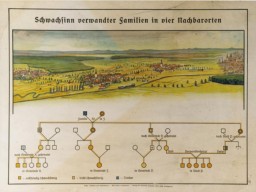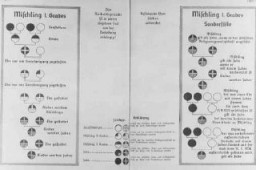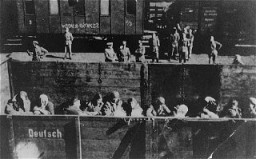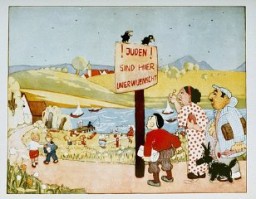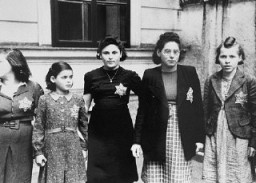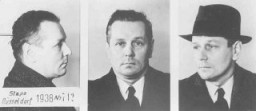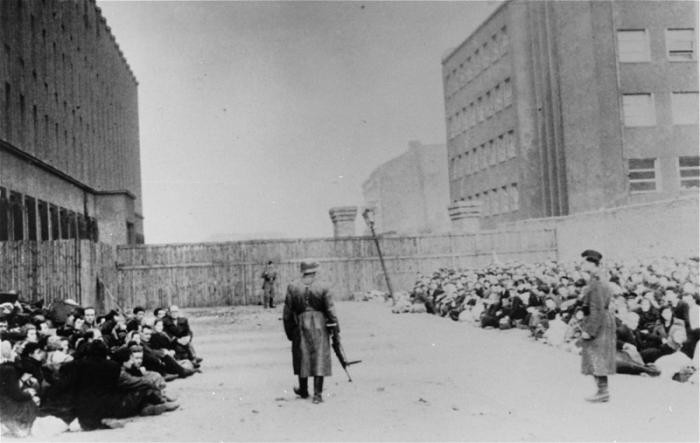
What Groups of People did the Nazis Target?
Nazi Germany persecuted, brutalized, and murdered millions of people in the name of Nazi ideology. In some cases, they did so with the help and support of their allies and collaborators.
-
1
Nazi Germany dehumanized and devalued entire groups of people on the basis of Nazi ideology. Nazi ideology was racist, antisemitic, and ultra-nationalist.
-
2
The Nazis considered Jews to be their number one enemy. During World War II, Nazi Germany and its allies and collaborators murdered six million Jews in a genocide now known as the Holocaust.
-
3
In addition to the genocide of Europe’s Jews, the Nazis also targeted additional groups of people whom they saw as enemies or threats.
Nazi Germany persecuted, brutalized, and murdered groups of people whom they saw as enemies or threats. The Nazis saw Jews as their primary enemy. They targeted Jewish men, women, and children with unrelenting focus. The scope of terror and the scale of human loss raise the questions: What groups did the Nazis target? And why did they target these specific groups of people?
Nazi Germany targeted Jews because the Nazis were radically antisemitic. From the very beginning, the Nazi German regime took steps to ruthlessly and tirelessly isolate, impoverish, and discriminate against Jewish people in Germany. During World War II, this policy escalated to mass murder. In total, the Nazis and their allies and collaborators murdered six million Jews in a genocide now known as the Holocaust.
In addition to the genocide of Europe’s Jews, the Nazis also persecuted, brutalized, or murdered additional groups of people. In some cases, they did so with the help of their allies and collaborators.1
The Nazis targeted people as members of the following groups (listed in alphabetical order for ease of reference):
- Black people in Germany;
- civilians (non-Jewish) accused of disobedience, resistance, or partisan activity;
- gay men, bisexual men, and other men accused of homosexuality in Germany;
- Jehovah’s Witnesses;
- people with disabilities;
- Poles;
- political opponents and dissenters in Germany;
- Roma and other people derogatorily labeled as “Gypsies”;
- social outsiders in Germany derogatorily labeled as “asocials” or “professional criminals”; and
- Soviet Prisoners of War.
Why did the Nazis target groups of people for persecution and murder?
Nazi Germany dehumanized and devalued entire groups of people on the basis of Nazi ideology. Ideology is a set of beliefs about how the world operates. Nazi ideology was racist, antisemitic, and ultra-nationalist. It drew on a number of existing concepts. These concepts included racism, nationalism, antisemitism, anticommunism, antigypsyism, and eugenics. The Nazis combined these concepts and took them to destructive, murderous extremes.
The Nazis evaluated people according to biological, racial, political, and social criteria. According to Nazi ideology, certain groups of people—such as Jews and Roma—were racial threats that undermined the racial purity of the German people. Others—such as people with disabilities—were considered biological threats. The Nazis believed they compromised the genetic health of the German people. Still others were seen as social, political, and/or ideological threats to Nazi control in Germany and beyond. During World War II (1939–1945), the Nazis conquered much of Europe. They treated real and supposed enemies as existential threats. Among those targeted as existential threats were members of the Polish elite, Soviet Prisoners of War, and members of resistance groups. During the war, Nazi Germany perpetrated a genocide of Europe’s Jews and numerous other mass atrocities.
How did the Nazis target Jews?
Nazi Germany persecuted and murdered millions of Jewish people because the Nazis were radically antisemitic. This meant that the Nazis were prejudiced against and hated Jews.
Their intense hatred of Jews drove the Nazis to obsessively seek ways to make Germany, and ultimately Europe, “free of Jews” (“judenrein”). Beginning in 1933, the Nazi German regime used discriminatory laws to drive Jews out of all aspects of German life.
During World War II, Nazi leaders radicalized their treatment of Europe’s Jews. Their actions escalated from persecution to mass murder. In 1939, Germany invaded Poland. Soon after, Nazi German authorities imprisoned Jews in ghettos. Many Jews died as a result of disease, starvation, and brutal treatment. After Germany attacked the Soviet Union in 1941, the Nazis and their allies and collaborators began to commit mass shootings of entire Jewish communities in occupied eastern Europe. In 1941–1942, Nazi Germany created killing centers to murder Jewish people using poison gas. With the help of their allies and collaborators, they deported Jews of all ages to their deaths.
In total, Nazi Germany and its allies and collaborators murdered six million Jews. The systematic persecution and murder of Europe’s Jews is now known as the Holocaust. The Nazis’ unrelenting fixation on targeting and ultimately destroying the Jewish people made the Holocaust unique among Nazi German atrocities.
How did the Nazis target non-Jewish groups of people?
The Nazis targeted Jews and other groups of people in different, but overlapping ways. In some cases, they did so with the help of their allies and collaborators.
The Nazis targeted the groups of people listed below with some combination of the following forms of persecution:
- extralegal imprisonment in a concentration camp;
- discrimination on the basis of supposed racial identity;
- torture, including inhumane medical experiments;
- forced sterilization; and/or
- mass murder.
Not all groups were subjected to all of these forms of persecution and brutality. For instance, the Nazis targeted some groups with discrimination and wrongful imprisonment, but not mass murder.
The Nazis did not target these groups with the same degree of intensity. Throughout the twelve years of the Nazi German regime, Jews remained the Nazis’ primary enemy and target. At varying points, the Nazis also turned their attention to other groups of people. The timing and intensity of Nazi persecution was based on a number of evolving factors, including Nazi ideology and practical realities (such as war). But, in all cases, the Nazis behaved with extreme cruelty.
For ease of reference, below is an alphabetical list of non-Jewish groups of people persecuted and/or murdered by the Nazis. Each section serves as an introduction to how and why they targeted a specific non-Jewish group of people.
Black People in Germany
Black people in Germany became victims of the Nazi German regime because the Nazis viewed them as racially inferior. When the Nazis came to power in 1933, there were several thousand Black people living in Germany. The Nazis applied the Nuremberg Race Laws to Black people. They referred to Black people using the derogatory label “Neger und ihre Bastarde” (“Negros and their bastards”). The people targeted as part of this group included Africans, African Americans, multiracial people, and other people racialized as Black and living in Germany. This group included several hundred multiracial children who were born in the Rhineland region of Germany in the interwar era. These children had a variety of ethnic backgrounds (including Arab and Vietnamese). However, they were all labeled as Black and derogatorily referred to as the “Rhineland Bastards.”
While there was no centralized, systematic program targeting Black people in Germany for murder, many were imprisoned, forcibly sterilized, and murdered by the Nazis. An unknown number of them, perhaps hundreds, were killed.
Civilians (non-Jewish) Accused of Disobedience, Resistance, or Partisan Activity
During World War II, Nazi German authorities brutalized and murdered innocent civilians in the name of eliminating resistance to German occupation. Throughout occupied Europe, Germans and their allies and collaborators targeted real and suspected members of resistance groups. They arrested, tortured, imprisoned, and sometimes executed individuals. The Germans also targeted non-German civilians, including foreign forced laborers, who violated German-issued decrees, policies, or other regulations.
The Germans also carried out collective punishment. Together with their allies and collaborators, they killed innocent civilians in massacres. The Nazis called the killings “reprisal actions” or “anti-partisan pacification measures.” During these massacres, the perpetrators sometimes leveled entire villages. They often murdered all of the inhabitants. This type of terror was far more common in occupied eastern and southern Europe than it was in western and central Europe. In occupied Poland and the occupied territories of the Soviet Union, the Nazis were especially indiscriminate and cruel. In total, hundreds of thousands of people became victims of reprisal massacres. Victims included Belarusians, Greeks, Italians, Poles, Russians, Serbs, Ukrainians, and others.
Gay Men, Bisexual Men, and Other Men Accused of Homosexuality in Germany
The Nazi German regime persecuted gay men, bisexual men, and other men as part of its campaign against male homosexuality. The Nazis saw gay men as threats to the birth rate and thus to the fate of the German people. They arrested tens of thousands of men under Paragraph 175. Paragraph 175 was the statute of the German criminal code that banned sexual relations between men. In Germany, there was no similar law prohibiting sexual relations between women. Nonetheless, the Nazis created a climate of restriction and fear for many lesbians.
Between 5,000 and 15,000 men were imprisoned as “homosexual” (“homosexuell”) offenders in concentration camps. Some men accused of homosexuality were forcibly castrated. This group of prisoners was typically required to wear a pink triangle on their camp uniforms as part of the prisoner classification system. Hundreds, or possibly thousands, died.
Jehovah’s Witnesses
Nazi Germany persecuted Jehovah's Witnesses because of their refusal to give up their religious beliefs and serve the Nazi German regime. Jehovah’s Witnesses refused to give the Nazi salute, join Nazi Party organizations, take the oath to Adolf Hitler, or let their children join the Hitler Youth. As pacifists, they also refused to serve in the German military.
In Germany, the Nazis banned many Jehovah’s Witness activities and publications. Authorities sometimes took Witnesses' children from their families and placed them into foster care. Many male Witnesses who refused military service as conscientious objectors were executed. Thousands of Jehovah’s Witnesses from Germany and occupied Europe were imprisoned in concentration camps for refusing to comply with Nazi demands. In the camps, Jehovah’s Witnesses had to wear purple badges. About 1,700 Jehovah’s Witnesses were killed during the Nazi era.
People with Disabilities
 Nazi Germany persecuted and murdered people with disabilities because the Nazis viewed them as biologically inferior. In order to eliminate this supposed hereditary threat, the Nazi German regime implemented a radical form of eugenics. In 1933, Nazi Germany enacted the Hereditary Health Law. This law resulted in the forcible sterilization of about 400,000 people diagnosed with certain supposedly hereditary disabilities.
Nazi Germany persecuted and murdered people with disabilities because the Nazis viewed them as biologically inferior. In order to eliminate this supposed hereditary threat, the Nazi German regime implemented a radical form of eugenics. In 1933, Nazi Germany enacted the Hereditary Health Law. This law resulted in the forcible sterilization of about 400,000 people diagnosed with certain supposedly hereditary disabilities.
In 1939, the Nazi German regime began to murder children born with certain disabilities. Soon after, authorities began to kill adults with disabilities living in institutions and care facilities. German doctors and nurses carried out these murders as part of the Euthanasia Program (codenamed Aktion T-4). Authorities killed tens of thousands of people with disabilities in gas chambers at euthanasia program killing centers. They sometimes killed people by giving them lethal doses of medication or starving them. German units also shot people with disabilities in occupied eastern Europe. In total, some 250,000–300,000 people with disabilities were killed.
Poles
Nazi Germany persecuted and murdered Poles during World War II. They did so because they saw Poland and certain Polish people as obstacles to their expansionist goals. They viewed Polish people as “subhumans” (Untermenschen), suited only to be Germans’ slaves.
Beginning in 1939, the Nazis conquered Polish territory. They planned to turn much of it into “living space” (Lebensraum) for the German people. German authorities carried out ethnic cleansing in occupied Poland. They tried to Germanize Polish people, places, and territory. German authorities carried out special murder operations against Polish educated elites. They imprisoned and shot tens of thousands of people in these operations. Among the victims were Polish school teachers, university professors, clergy, politicians, and others.
German authorities also forcibly displaced Poles from their homes. They stole their land and property. They kidnapped tens of thousands of Polish children for Germanization. German authorities exploited Poles for forced labor. And they responded harshly to any signs of Polish opposition. For example, they leveled entire Polish villages as retaliation for alleged partisan activities. They also arrested and imprisoned tens of thousands of Poles in concentration camps as political prisoners. In total, about 1.8 million Poles were murdered by the Germans during World War II.
Political Opponents and Dissenters in Germany
Nazi Germany persecuted German political opponents and dissenters who expressed opposition to the Nazi Party or the Nazi regime. Immediately after coming to power, the Nazis carried out an assault on German democracy. They rapidly arrested and abused tens of thousands of leaders from opposing political parties. In particular, they targeted Communists and Social Democrats. The Nazis transformed Germany from a democracy with free speech and a free press into a dictatorship that banned dissent in all forms. Many Germans supported this transformation and embraced the regime. But a small minority of Germans chose to express opposition for ethical, religious, political, or other reasons.
Germans who openly spoke out against the Nazis were punished. Many were imprisoned in concentration camps as political prisoners, where they had to wear red badges on their camp uniforms. The regime broadly defined what constituted treason or treasonous activities. For example, telling a joke about Adolf Hitler could be grounds for arrest and even execution. During World War II, Germans who were caught engaging in active resistance were often executed. Tens of thousands of German political opponents and dissenters were killed.
Roma and Other People Derogatorily Labeled as “Gypsies”
Nazi Germany and its allies and collaborators persecuted and murdered Romani people and other people derogatorily labeled as “Gypsies.” They did this because the Nazis espoused antigypsyism. Antigypsyism, also called anti-Roma sentiment, is the hatred of or prejudice against Romani people and other people derogatorily labeled as “Gypsies.” The Nazis viewed Roma as racially inferior and socially delinquent.
In the 1930s, Nazi Germany persecuted Romani people using racial laws and other means. In 1935, German authorities began to establish Zigeunerlager (“Gypsy camps”) where they interned Romani families. They forcibly sterilized Romani people, legally and extralegally.
Nazi policy towards Romani people radicalized after World War II began. During the war, the Nazis and their allies and collaborators committed a genocide of European Roma. They murdered Romani people in killing centers, in mass shooting operations, and through brutal treatment in ghettos and camps. The “Gypsy Camp” (Zigeunerlager) at Auschwitz was particularly infamous. At Auschwitz and other concentration camps, Nazi doctors subjected Romani prisoners to cruel medical experiments. In total, at least 250,000—but possibly as many as 500,000—Romani people were killed.
Social Outsiders in Germany
The Nazi regime persecuted certain Germans whom they considered to be social outsiders. They targeted people who were marginalized and impoverished, as well as people with certain types of criminal records. The Nazi German regime referred to these Germans using the derogatory labels “asocials” (“Asozialen”) and “professional criminals” (“Berufsverbrecher”). People labeled as “asocials” often lacked permanent addresses or stable jobs. Many had been arrested multiple times for begging, vagrancy, or prostitution. The Nazis viewed them as biologically inferior and/or socially deviant. People labeled as “professional criminals” usually had criminal records for property crimes and many were recidivists. But some had never been charged with a crime.
The Nazi German regime cruelly mistreated people it considered social outsiders. Those viewed as social outsiders were often forcibly sterilized. They were also wrongfully and indefinitely imprisoned in concentration camps. In the camps, people imprisoned as “asocials” had to wear black badges. Those who were imprisoned as “professional criminals” had to wear green badges. Tens of thousands of people labeled as “asocials” or “professional criminals” died as a result of Nazi policies.
Soviet Prisoners of War
During World War II, Nazi Germany committed the systematic mistreatment and mass murder of Soviet Prisoners of War (POWs). The Nazis treated Soviet POWs with a level of extreme cruelty that differed from their treatment of British, French, or American POWs. They did so because the Nazis viewed the Communist Soviet Union (USSR) as an existential enemy that needed to be annihilated. They viewed many of the peoples who lived in the Soviet Union as racially and culturally subhuman.
Nazi Germany invaded the Soviet Union in June 1941. The German military quickly captured millions of Soviet soldiers. Sometimes the army conducted summary executions of POWs. The SS and police routinely selected and killed tens of thousands of Soviet POWs just because they were Jews, political commissars, or members of the Communist Party. A significant number of Soviet POWs from Central Asia were also executed by the Nazis because of their race or because they were circumcised and mistaken for Jews. Other Soviet POWs were subjected to long marches, systematic starvation, no medical care, little or no shelter, and forced labor. Many were held under exceptionally brutal conditions in POW camps and in concentration camps. The German treatment of Soviet POWs was particularly cruel in 1941 and early 1942. By war’s end, about 3.3 million Soviet prisoners (about 58 percent) died in German captivity. Most had been killed in the first eight months of the German-Soviet war.
Series: Nazi Racism
Series: Victims of the Nazi Era
Series: Gay Men and Lesbians under the Nazi Regime
Switch Series
Critical Thinking Questions
- <p>How and why do regimes target individual groups?</p>
- <p>Consider a more recent example of a specific group targeted for persecution and/or destruction. How are members of the group identified, separated, and brutalized?</p>
- <p>What options do other nations or coalitions have when a civilian group is targeted for discrimination and/or destruction within one country?</p>
Further Reading
Altman, Linda Jacobs. The Forgotten Victims of the Holocaust. Berkeley Heights, NJ: Enslow, 2003.
Berenbaum, Michael. A Mosaic of Victims: Non-Jews Persecuted and Murdered by the Nazis. New York: New York University Press, 1990.
Friedlander, Henry. The Origins of Nazi Genocide: From Euthanasia to the Final Solution. Chapel Hill: University of North Carolina Press, 1995.
Grau, Günter. Hidden Holocaust: Gay and Lesbian Persecution in Germany, 1933-45. Chicago: Fitzroy Dearborn, 1995.
Gutman, Israel, and Shmuel Krakowski. Unequal Victims: Poles and Jews During World War Two. New York: Holocaust Library, 1986.
Hesse, Hans, editor. Persecution and Resistance of Jehovah's Witnesses During the Nazi Regime, 1933-1945. Bremen, Germany: Edition Temmen, 2001.
Lewy, Guenter. The Nazi Persecution of the Gypsies. New York: Oxford University Press, 2000.
In this context, “allies” refers to Axis countries officially allied with Nazi Germany. “Collaborators” refers to regimes and organizations that cooperated with German authorities in an official or semi-official capacity. These German-backed collaborators included some local police forces, bureaucracies, and paramilitary units. The terms “allies” and “collaborators” can also refer to individuals affiliated with these governments and organizations.
